 [Image: London nuked, courtesy of CarlosLabs].
[Image: London nuked, courtesy of CarlosLabs]."This mapplet," we read, "shows the thermal damage caused by a nuclear explosion. Search for a place, pick a suitable weapon and press 'Nuke It!'"
The image you see above is London as decimated by an atomic bomb equivalent to the freakishly terrifying Soviet Tsar Bomba test of 1961. Everything as far as Guildford has been damaged – the entire center of the city simply gone.
Below, we see Chicago obliterated by the same size of explosion. Looking closely, we see that the difference between a first- and second-degree burn – and this information is explained a bit more, below – passes directly through the distant suburban town in which I was born, Highland Park.
 [Image: Courtesy of CarlosLabs].
[Image: Courtesy of CarlosLabs].Waters along the shore of Lake Michigan would be instantly evaporated, forming radioactive rainstorms over northern Indiana, perhaps for days.
The size of the bomb can be varied, of course; here we see Los Angeles hit by any typical nuclear warhead carried by an American fighter jet, circa 1991; and, below that, we see New York City hit by a bomb equivalent to Fat Man, the device dropped on Nagasaki.
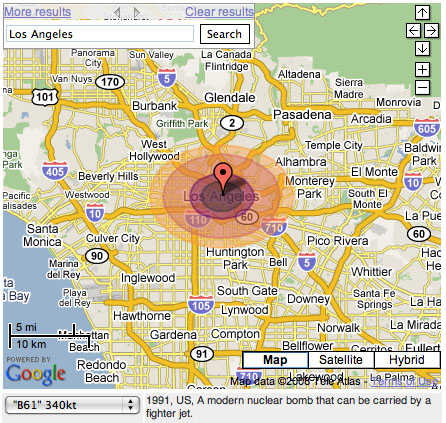
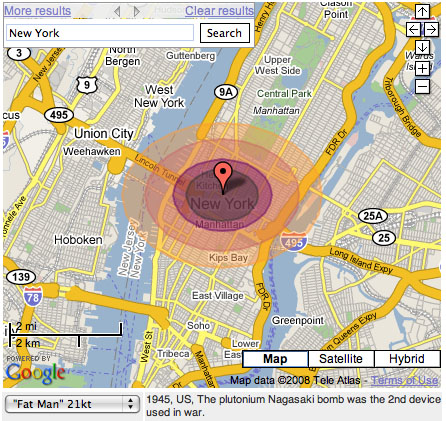 [Images: Courtesy of CarlosLabs].
[Images: Courtesy of CarlosLabs].And here, below, is Rome hit by Little Boy, the bomb dropped on Hiroshima – and the first nuclear device ever used as an act of war.
If it's any consolation to Catholics – or architectural historians – the extreme, northwestern fringes of the Vatican would escape immediate harm.
 [Image: Courtesy of CarlosLabs].
[Image: Courtesy of CarlosLabs].Alternatively, let's drop Little Boy on Edinburgh.
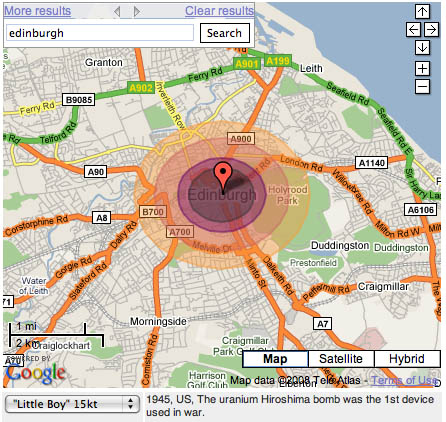 [Image: Courtesy of CarlosLabs].
[Image: Courtesy of CarlosLabs].All of this is visually arresting – seeing vast bruises like bull's eyes consume whole cities – but what does it really mean? What is each colored circle supposed to represent?
In the following image of Mumbai being hit by a nuclear missile equivalent to those used by the Chinese military, we see concentric rings of 1st, 2nd, and 3rd degree burns expanding outward from the detonation – a geometry of necrosis, suffocation, and death. Blisters and cancer would affect tens of thousands of people for miles in every direction (depending on prevailing winds).
 [Image: Courtesy of CarlosLabs].
[Image: Courtesy of CarlosLabs].For some unexpected astronomical context, though, CarlosLabs has added a bizarre final option: seeing how asteroid impacts might compare with inter-urban nuclear war.
Tokyo – where the following image is centered – is not merely erased; struck by an asteroid, it's been placed at the heart of a planetary event, complete with rings of sunburn-equivalent injury spreading out across whole continents.
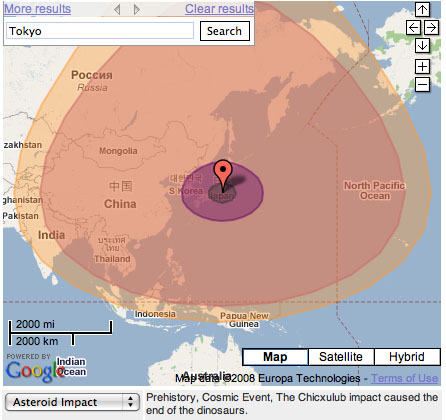 [Image: Courtesy of CarlosLabs].
[Image: Courtesy of CarlosLabs].Returning to the realm of historical likelihood, the image that somehow clarifies this the most for me – if, for no other reason, because I live there – is the following glimpse of San Francisco. The entire peninsula has been blasted into absolute, smoking oblivion by an explosion equal to Tsar Bomba.
The fact that you would be more or less screwed as far south as Fremont – and well east of Oakland – seems sobering, indeed.
You could be sitting in the west-facing window of an Oakland high-rise, watching an atomic fireball explode over San Francisco – which quickly expands to melt the glass you're looking through.
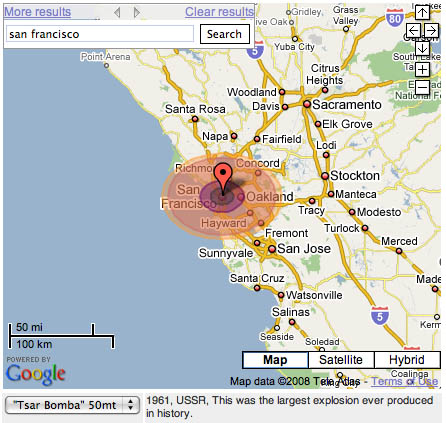 [Image: Courtesy of CarlosLabs].
[Image: Courtesy of CarlosLabs].A few quick points, meanwhile:
1) This will mean very little, and have no effect, but I am 100% behind complete nuclear disarmament. The U.S. taking the lead in this seems like something well worth pursuing.
2) In this context, I have to say that the books of Richard Rhodes cannot be recommended highly enough. His The Making of the Atomic Bomb – which I have to confess to having read only partially – is required reading for anyone interested in what intensive, well-funded efforts of design can – in this case, unfortunately – produce. The bomb as an act of national infrastructure.
3) Michael Light's book 100 Suns, a photographic survey of nuclear weapon tests, is as horrifying as it is visually spectacular, especially for anyone with an interest in human history (and its explosive intersection with enriched geology).
4) Gary Snyder has a great poem that I still think of now and again, 17 years after first reading it, called "Bomb Test." Originally written, I believe, in Kyoto in 1986, the poem presents nuclear weapons as a kind of new terrestrial element, something geologically unprecedented both in and on the surface of the earth – highly processed samples of mineral chemistry (uranium, plutonium) put into military service by rival superpowers.
"The fish float belly-up, for real," Snyder writes. "Uranium in the whites / of their eyes.
- They've been swimming
Deep down where it's black when a
Silvery snow of something queer
glinted in
From cirrus clouds to the seamounts,
Through all the food chains,
Shrimp to tuna, the currents,
Riding the waves.
Even now, the globally nomadic residues of nuclear weapons tests form a ghostly stratigraphic marker that can be found literally around the world, an all but permanent part of the earth's sedimentary record.
So, in the images that illustrate this post, we see what effects this geological discovery – the explosive power of rare elements – could have on the built geography of our species.
Nuclear war thus poetically equates to hurling enriched fragments of the earth's surface at your rivals. Call it weaponized geology: minerals made altogether unearthly, if not post-terrestrial, through anthropological intervention.
5) Here is a random assortment of nuclear bomb photography. These were all Cold War-era tests – but, someday, perhaps soon, architects and architecture bloggers will be looking at similar images, images that have captured the obliteration of constructed environments from Mumbai or Karachi to New York, London, or Tehran. This will happen, I would say; it might well occur within our lifetimes, or at least within the next century; and any even partially accurate future assessment of global urbanism must still take nuclear weapons into account.
Nuclear weapons present us with a kind of demonic skeleton key, capable of catastrophically unlocking any city in the world, no matter how dense or well-fortified, in mere seconds.
 Finally, here is what would happen if a nuclear bomb was dropped on a relatively non-urban environment: in this case, the town of Chapel Hill, North Carolina.
Finally, here is what would happen if a nuclear bomb was dropped on a relatively non-urban environment: in this case, the town of Chapel Hill, North Carolina. [Image: Courtesy of CarlosLabs].
[Image: Courtesy of CarlosLabs].But this could just as easily have been Ann Arbor, Santa Cruz, Austin, Shrewsbury, Castleton, Aberystwyth, Marburg – it could just as easily have been anywhere on earth.
The overwhelming obliterative power of nuclear weapons turns them into a kind of ubiquitous anti-landscape, something that no geography, built or natural, can successfully resist.
All of which is simply a long-winded way of saying that while we now tend to measure threats against our cities in terms of armed gangs or contextually minor moments of staged terrorist assault, it's still interesting to remember that, hovering over all of this, is something that could simply annihilate cities altogether.
If we're going to study cities, in other words, then we should also study that which is radically anti-city.
(Spotted via Alexis Madrigal and Wired Science).
No comments:
Post a Comment